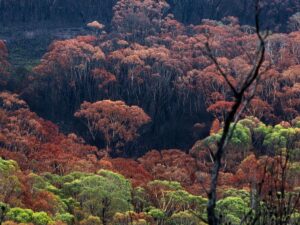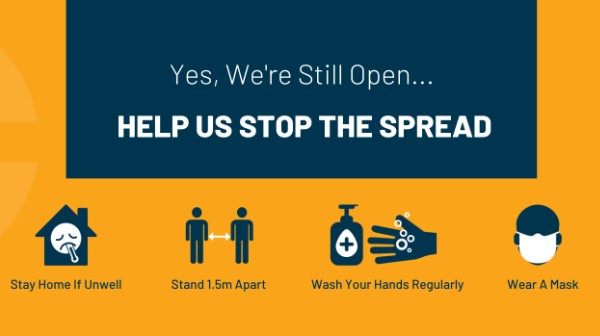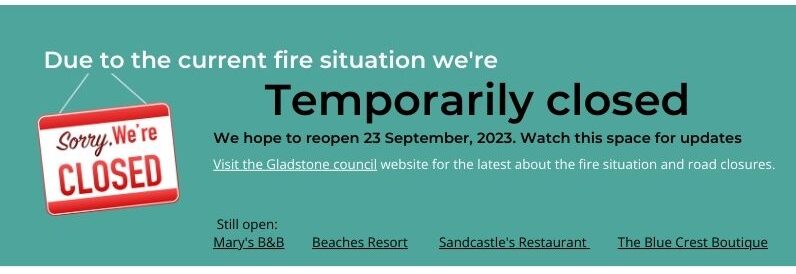Case study: natural disaster communication
In this topic we have created detailed communication samples as well as insights pertaining to a natural disaster.
What to do when disaster happens

When a natural disaster or crisis hits your area, you need to be able to let visitors know if and how your business has been affected, whether it is safe to visit your region and whether your region has the capacity to accept visitors.
The intensity of media coverage during a natural disaster is necessary in order to keep local communities and the general public informed about the current state of events. News coverage can also be very beneficial to local communities in that it encourages empathy and generosity, resulting in more money and other resources being donated to the people who need it most.
Unfortunately, the ongoing effects of news coverage can be far less positive for the tourism economy. Bushfire, floods and other disaster media coverage can create a fearful reaction among audiences and damage the reputation of tourism regions during and after a disaster. Would-be travellers are likely to become wary and be deterred from visiting the area even after the danger has passed, slowing the recovery of tourism towns.
Share your status with visitors
One of the first actions you should take is to provide a factual update on the status of your business in the context of the disaster that is affecting your region. You know your area best and in light of a natural disaster, it becomes your responsibility to share the information you have with your audience. People who are unfamiliar with your region are not going to be aware of your specific situation. You can give them guidance and reassurance by acknowledging the situation and giving them the facts.
Give an honest account of what’s happening with your business and your area. Consider and respond to the following questions:
- Are you open or have you had to shut your doors temporarily?
- Are you near to the danger or far away?
- If you are a tour operator, have you had to reroute any of your tours or are you operating as usual?
- If you are close to the danger zone, provide information about your proximity to the danger and any road closures that visitors should be aware of.
- What is your business doing to stay on top of emergency advice? How are you applying that advice to your business operations?
The key here is to try to imagine what your audience is thinking and what they’re worried about. They are likely to be concerned about the possible need to evacuate, about air quality, about whether other businesses and attractions in the region are still operating. You can address these concerns through social media posts and by putting up a notice on your website. Depending on the content of your post, consider accompanying the update with a photo of your staff outside with big smiles ready to welcome guests or a photo of the business managers looking capable and relaxed.
Your audience will appreciate your honesty and openness about the situation.
Create a website banner
Outsiders are likely to be unclear on what areas are safe to visit and which businesses are still operating. It’s your responsibility to clarify your position to potential visitors, however, repeatedly responding to enquiries about the status of your business can be tiring. A good way to head off these enquiries is to clarify your position on your website.
Adding a banner or notice on your website homepage to let visitors know the current status of your business – i.e. “We are open” or “We are closed”. The banner should provide links for them to access the latest information updates about road closures and so forth.
Website banner for businesses that still operating

Even if your business was unaffected by the events in your region, it’s natural that outsiders might be unclear on what areas are safe to visit and which businesses are still operating. It’s your responsibility to clarify your position to potential visitors, however, repeatedly responding to enquiries about the status of your business can be tiring.
A good way to head off these enquiries is to clarify your position on your website. Add a banner or notice on your website homepage to let visitors know that your business is still operational. The banner should provide links for them to access the latest information updates about fire warnings and road closures. See the example below.
Website banner for businesses that are temporarily closed

If you have had to shut down operations of your business temporarily due to safety concerns, or if you need some time to redevelop your business before welcoming guests back, then you also need to ensure you are communicating clearly with guests and potential visitors about your operating status.
An easy way to let any potential visitors to your business know that you are temporarily closed is to put a notice on your website. This is a quick and easy way to communicate to website visitors that you are not operating right now, by when you hope to reopen and how they can stay informed. It also directs travellers to alternative businesses in your region that are currently open and need support.
Create an email response template
You are likely to receive phone calls and emails from concerned travellers who want to double-check that it is still safe to visit. It’s important to address the concerns of these guests and provide accurate information in order to reassure them. Keeping up with a constant slew of enquiries can be time-consuming and monotonous. So to save yourself some time, and possibly a headache, customise one of the below templates so that you have a concise response that you can copy and paste and edit as necessary.
Enquiry response template message for businesses that are still operating
Below we have prepared a template for you and your team to adapt and utilise in response to any enquiries that you might receive in the wake of a disaster event.
Copy and paste from the template below:
“Hello (name),
Thanks for getting in touch with us. We are happy to let you know that our business has been completely unaffected by the recent fires/cyclone/floods in our area. We are fully operational and are running all services according to our usual schedule. We understand that you may have concerns about how (town/region name) has been affected by these events and I’d like to clarify what the current situation is in our area.
Although there has been damage to some parts of the area, many fabulous local attractions are still open to the public, we’d love for you to include them on your itinerary and show our region some love during this time.
The below attractions are operating as usual:
(list any visitor attractions, national parks, restaurants, wineries, breweries, accommodation providers and tour companies that you know are still operating)
Unfortunately, the below attractions are currently in recovery and therefore closed temporarily:
(list any visitor attractions, national parks, restaurants, wineries, breweries, accommodation providers and tour companies that you know are currently not operational. Limit this list to only mention the major attractions that you know your guests are likely to enquire about)
For the latest information about the bushfires/cyclone/floods please visit the (your state) emergency website, for information about road closure please visit the (your state) traffic website (add hyperlinks).
If you have any further enquiries or would like to make a booking please call us, email us or use the ‘book now’ button (add hyperlink) on our website.
We can’t wait to welcome you to (business or region name)!
Thank you,
(Your name) and all of the team at (your business name).”
Enquiry response template message for businesses that are temporarily closed
Even though your business might be out of action right now, it’s important not to discourage potential customers from visiting your region entirely. You can support your local economy by encouraging visitors to come and visit other nearby businesses that are operational. It’s also an opportunity to lay foundations for future communication by encouraging them to follow your social media channels and blog. We have prepared a template for you to adapt and utilise in response to any booking enquiries that you might receive while your business is preparing to re-open.
Copy and paste from the template below:
“Hello (name),
Thanks for getting in touch with us. Our business is currently recovering from the damages that we incurred during the recent disaster in our region so we’re sad to advise that we will not be able to accept your booking at this time.
Although WE are not able to take your booking right now, we would love for you to still visit our region. There are plenty of areas that are untouched or are recovering very quickly. You may be interested in visiting one of our neighbouring businesses that are ready to take your bookings now! You can find more information about them here: (provide links to any local businesses that are open and ready).
We are aiming to re-open our doors by June* this year (adjust recovery time as is relevant to your business) and we hope you come back to visit us then. You can follow our journey here on our Facebook page, Instagram account and news page (add hyperlinks).
Thank you,
(Your name) and all of the team at (your business name).”
Speaking with other local operators
In the wake of a natural disaster, one of the main concerns your guests will have is whether or not there will be anything for them to do if they visit. They may be up to date with how YOU are going because you have been so good with your communication…. but what about everyone else? You and other tourism operators in your community can step up here by communicating with one another. You need to find out who is operating, who isn’t, who has been affected, and what attractions are still viable.
A good place to start is to consider what recommendations you normally make to your guests. Think about the frequently asked questions you receive, questions such as, “Where should I go for dinner tonight?” – or – “What kid-friendly activities can you recommend for the weekend?”. Consider what your frequently asked questions are and start there. Make a list of 5 – 15 local tourism operators and give each business a call to find out how they are faring and if there’s anything you should know before recommending them to guests. This will also put you on their radar so that they can recommend you to their customers as well. Win-win!
Then, we recommend promoting other businesses in your social media and blog posts. Have a look using your local tourism hashtags for great posts by other local businesses that are compatible with your product. This is great for those operators who sometimes have trouble coming up with new content ideas for their social media channels. This gives you something to talk about when you feel like you’ve got nothing to talk about.
Doing this shows your audience that there is plenty to do in your region, and lets them know that they should not be concerned about your community not being ready to accept guests. You are saying, “Look at all of these brilliant things to see and do – book now, don’t wait!”, and boosting the attractiveness of your destination as a whole.

You are a holiday accommodation provider
A potential guest named Sarah, who is considering booking a week-long stay for her family of four, is browsing your website. She is interested in making a booking, however, she is concerned that there will be no options for activities for her kids to do during their stay because of the recent bushfires that passed through your area. Luckily, you have prepared for this. You have called around to the businesses that you would normally recommend to a guest like Sarah to find out who is operating and who isn’t. You have put that information into a blog post with a list of local recommendations presented in the context of the recent bushfires. Sarah notices the blog post on the booking page, reads through and is happy to see that the nearby maze and wildlife parks are still open, as well as a few of the main kid-friendly restaurants. Sarah is reassured and proceeds with her booking.
Understanding outsider perceptions
After a highly publicised event such as a major bushfire or floods, visitors will have concerns and mixed emotions about travelling to your region. The public is likely to be wary about the safety and viability of the region as a tourism destination. They are also likely to feel a lot of empathy for the impacted communities and be looking for a way to contribute. In order to encourage visitors to come to your region sooner, you will need to adjust your marketing messaging to address the disaster in a way that considers these factors.
Research conducted by Dr Gabby Walters & Dr Judith Mair (2010) of the University of Queensland Business School has found that regular visitation is likely to resume after 12-24 months, although regular visitors (people who have visited 5 times or more) are more likely to visit within 6 months after the events. Their research has also shown that post-disaster marketing is likely to attract visitors who are unfamiliar with the affected region, which means that this can become an opportunity to introduce new customers to your business.
Tourism businesses have a few different directions to take when putting together their marketing messages. The three approaches explained below have been found to have the best effects according to post-disaster tourism research (Walters & Mair 2010).
Community readiness – “We are ready to welcome you!”
Visitors want to feel confident that the area is ready to receive visitors despite the damage that may have been done. They may be worried about being a burden on an already struggling community and feel that by visiting now, they are getting in the way of recovery. These visitors, therefore, need to be reassured that the town is ready to welcome them. Research has shown that community readiness is one of the most effective messages to use in post-disaster marketing.
Example messages:
- “Our community spirit is strong and we want to share it with you.”
- “We are a foodies paradise – our cafes, restaurants, microbreweries and providores are waiting to welcome you.”
- “We are feeling grateful that so much of our beautiful region remains open for business during such a challenging time. We’d love to see you here (and we know you’ll love it too).”
Outsider empathy – “Come and show your support!”
The generosity of others during times of disaster is something to be admired. People are incredibly willing to offer support to others in their time of need. Tourism businesses can incorporate this into their messaging by letting visitors know that one of the best ways to help a tourism town to recover is to visit in person.
Example messages:
- “The best way you can support us is to do business with us, and we are open for business!”
- “Our region needs you now more than ever, come and show your support for our community.”
- “Wondering what you can do to support us after the fires? One way you can help is by visiting! With most of our business trading, there is so much to see and do!”
Testimonials and celebrity endorsements
Guest testimonials are perceived as highly credible. Positive quotes from guests who have visited during the recovery period can be reassuring to potential visitors. Interestingly, one of the most effective post-disaster advertising techniques is to capture the endorsement of a celebrity, this may not be possible for your business but if you are able to capture a testimonial from a relevant celebrity, it will be a great advantage.
Example testimonial:
“I visited the Blue Mountains with my partner immediately after the fires. Although there has been damage to some of the region, we were still able to visit our favourite attractions and enjoy many activities. We hiked, biked and kayaked our way through Katoomba and Wentworth Falls and even tried caving for the first time! All of the staff we encountered were so happy to see us. We’ll be back again soon.”
– Sally Seccombe, Sydney
Managing booking cancellations
Depending on how the events have impacted your region and your business, your future visitors with planned bookings may need or want to cancel. You need to consider how and if you will implement your cancellation policy and how you are going to encourage visitors to postpone, rather than cancel, their planned trips.
Case Study:
Agnes Water, QLD
In the early days of the 2020 Coronavirus pandemic, as it was becoming clear how extreme the government restrictions needed to be in order to manage the virus, the two-person team at Gibson’s Pet Friendly Accommodation realised they needed to work out a plan to manage all of the bookings already in place for the next few months. They put their heads together to work out the best approach that would allow them to retain as many bookings as possible and minimise their overall losses.The plan they developed was to try to convince all future guests to delay rather than cancel their bookings. Because their business is so small, their customer communication style was already very personalised, so they would carry that forward with this plan.The strategy focused on the idea that a holiday or getaway is something to look forward to, this became central in their communication. The message was, “You will have something to look forward to doing when this is all over!”.In terms of their cancellation policy, the team decided that they would provide a refund to anyone who asked for one. But to incentivise the trip, they offered a free night to anyone who decided to move their booking for a later date. They also extended this incentive to any new 3+ night reservations for after restrictions had lifted.The Result:Gibson’s Pet Friendly Accommodation provided $0 in refunds. Their ‘person-to-person’ style communication was very well received and the response from customers very heartwarming.
Key takeaways from this case study:
- Be personable. You and your staff are real people, just as your guests are. It pays to convey the ‘we’re all in this together’ message when you’re in a crisis.
- Focus on the why. Think about why your customers booked with you in the first place and relay that message back to them. Keeping their booking with you gives them something to look forward to when the crisis is over.
- Act swiftly and be clear. Don’t leave room for confusion by delaying your communication or being vague in your offer. The coronavirus has created enough doubt and confusion as it is – be a voice of clarity and reassurance for your customers.
- Incentivise! Reward them for spending their money with you in a way that works for your business.
Reach out to past customers
During the period following a natural disaster, it’s important to build the confidence that your target market has in your business. The most valuable asset you have right now if your existing customer email list.
In an ideal world, your email database would be segmented, your messages personalised for each recipient and you would be utilising automation and integration techniques. We understand that most businesses don’t have these best-practices in place yet. But, this shouldn’t stop you making use of email in your disaster recover marketing. So even if you don’t have a tidy aggregated database or CRM software you should include email in amongst your recovery marketing arsenal.
For those operators who don’t use any CRM tools and have never used an email list before, the most simple solution would be to gather the emails of all of your past customers from the last 2-3 years and create a spreadsheet with their names and email addresses. Obviously, the more personalised info you can track and record the better. You should aim to record information such as when the guest visited, who they were with (i.e. family/couple/single), where they were from, what age group they were in, etc. Even if you don’t have the capacity to segment your list right now for this email campaign, it’s great to keep track of this information so that you can target certain groups further down the track.
We want you to reach out to this group because you have already established a relationship with them. They have stayed with you or used your service or bought your products and have hopefully enjoyed their interaction with you so far. It’s very likely that they are aware that you may have been affected by the bushfires in your area and will be curious about what your current status is. That interaction with your business – those memories they made with you – gives them a small sense of ownership and responsibility for your region. If you think about the places that you yourself regularly holiday or have visited before, I’m sure you feel a certain special affection for that place. And that’s why we want to reach out to this group specifically.
For those operators who are temporarily closed while recovering:
Your email should focus on keeping your relationship going. Provide your past guests with an account of your experience and advise them that when you re-open you hope that they will visit you again. Also, let them know that when you do reopen you will be in touch with them again to let them know and invite them back.
For operators who are open for business:
Your email message should provide a similar account, but focusing on letting them know that you are open and you’d love for them to come back and they’d really be helping out if they did. You might like to extend them a special offer. Let them know that as they are previous customers you would like to offer them a special 25% discount, or whatever special offer works for your business.
In both scenarios, you are leaning on that memory that these guests have of their experience with you which ties them to your business.
You do need to get into the sales mode here and think about what you want the person receiving the email to feel and what you want them to do. So give them a call to action that they can engage with at the end of your email. If you can, we strongly suggest looking at an email platform such as MailerLite.
MailerLite makes it easy for you to personalise and customise email campaigns in a way that is very visually engaging and fairly simple and very professional. Eventually, you might wish to go one step further and use a more complex and adaptable solution that gives you extra functionality such as email automation.
